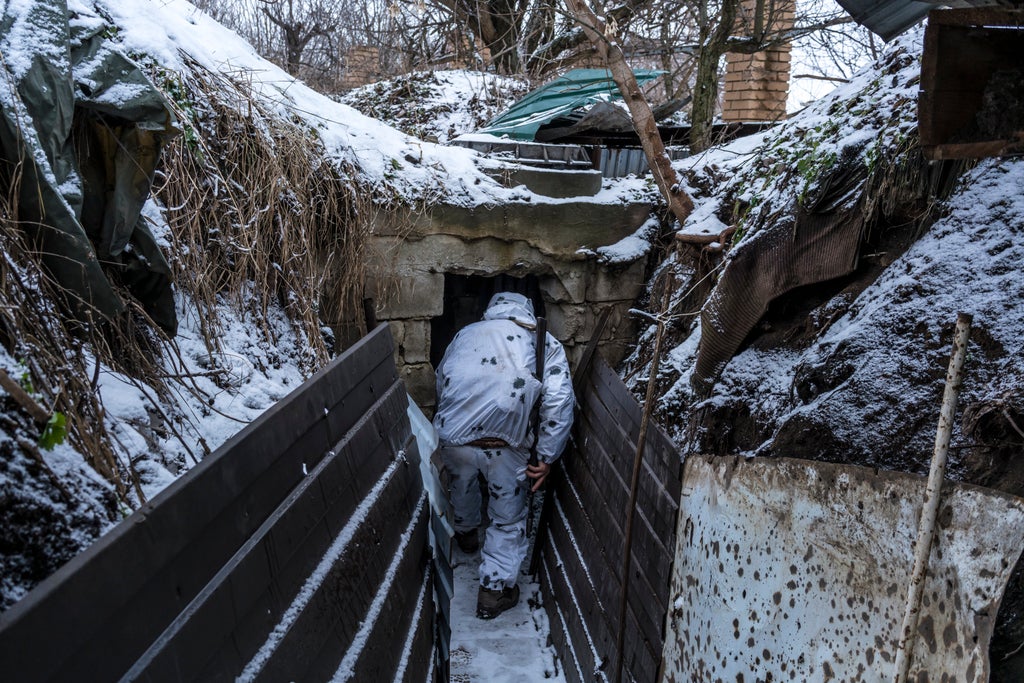
With more than 106,000 Russian troops stationed near the Ukrainian border, fears are growing that president Vladimir Putin will decide to invade.
The threat comes eight years after Russia annexed Crimea and sparked fighting in the Donbass region of eastern Ukraine, where a low-level conflict, which has killed more than 14,000 people, is still rumbling on between Kyiv and separatists.
Although the West hopes to alleviate tensions and the risk of war in the region, talks between the Kremlin and Nato have made no ground. And so, as things stand, it is far from clear what will happen next.
Nato has said it is sending additional ships and fighter jets to its deployments in eastern Europe, while the US and UK are withdrawing diplomats’ families from Ukraine.
Moscow has moved troops and materiel into neighbouring Belarus for military drills, and Washington is considering sending thousands of US soldiers to Nato allies in the Baltics and Eastern Europe, according to media reports.
Antony Blinken, the US Secretary of State, flew to Europe last week in a bid to defuse the situation. He held talks with his Russian counterparts, after meetings with the Ukrainian president Volodymyr Zelensky and other allies.
Yet the talks did not ease tensions, as Mr Blinken on Sunday warned that the US and its allies would deliver a “swift, severe and united response” if Russia attacked Ukraine.
Furthermore, US president Joe Biden struck a pessimistic tone in the White House last week, telling reporters that there will most likely be an invasion.
“My guess is he will move in. He has to do something,” he said of Mr Putin.
If this happens, Moscow “will pay a serious and dear price”, Mr Biden warned. This would include a raft of sanctions.
But analysts believe that such threats are unlikely to deter the Putin regime, which has tried in recent years to “sanction-proof” the Russian economy.
The current standoff comes as an attempted corrective to what Mr Putin perceives as Nato’s encroachment in countries like Ukraine that were previously ruled by Russia.
With polls showing that a large majority of Ukrainians would like their country to become a member of the organisation, the Kremlin wants the west to promise that Ukraine will never join Nato, something the defensive alliance has ruled out.
Mr Putin laid out his own thought on Ukraine and its relationship with Russia in a 5,000-word essay published last summer.
Entitled “On the Historical Unity of Russians and Ukrainians”, the treatise was “one step short of a declaration of war”, according to Anders Aslund, a senior fellow at the Stockholm Free World Forum.
The Russian president reiterated his claim that Russians and Ukrainians are “one people”, suggesting that Russia had been “robbed”.
In another part of the text, he offered more overt threats to Kyiv. “I am confident that true sovereignty of Ukraine is possible only in partnership with Russia,” Mr Putin wrote.
Months later, Mr Putin sent tens of thousands of troops towards Ukraine. And he is now expanding Russia’s military presence in the region, with more soldiers heading to Belarus for joint army drills scheduled for later this month.
There are currently 127,000 Russian personnel - 21,000 of whom are part of sea and air divisions - close to the border, the Ukrainian defence ministry said.
The UK and the US have recently given Ukraine military support, with the former flying anti-tank weapons to the country earlier last week.
However, such gestures are likely cold comfort for Kyiv when faced with the threat of a Russian invasion, given the significant gulf in military strength between the would-be combatants.
While Ukraine has under 250,000 troops and is looking to add a further 130,000 to its ranks, Russia has almost a million soldiers at its disposal. It also much more sophisticated and abundant military hardware.
Speaking of the disparity between the two armies, Vadym Prystaiko, Ukraine’s ambassador to the UK, said it is unfortunate that his country is not part of Nato.
“We are not part of this family and we are facing the biggest army in Europe by ourselves,” he said.
Russian officials have repeatedly denied planning to invade, yet Moscow has also moved troops to Belarus for what it calls joint military exercises, giving it the option of attacking neighboring Ukraine from the north, east and south.
Kremlin spokesman Dmitry Peskov said last week that Western weapons deliveries to Ukraine, military maneuvers and Nato aircraft flights were to blame for rising tensions around Ukraine.
Perhaps as a prelude to invasion, more than a dozen Ukrainian government websites were hacked earlier this month. The country’s foreign ministry said it was too early to say who was to blame, but added that “there is a long record of Russian cyberassaults against Ukraine”.
The hackers left an ominous message on the websites they had disabled. “Ukrainian! All your personal data was uploaded to the public network. All data on the computer is destroyed, it is impossible to restore it,” it read.
“All information about you has become public, be afraid and expect the worst. This is for your past, present and future,” the message added.







